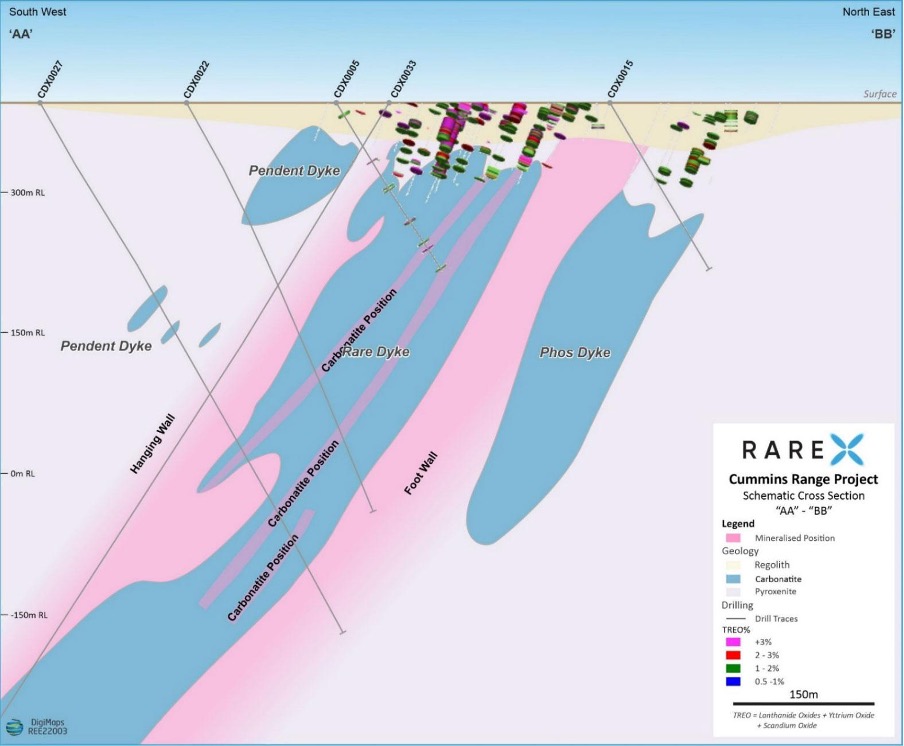RareX on the road to success with growing scale of its Cummins Range rare earths project

RareX says drill testing has expanded its Cummins Range rare earths deposit in Western Australia’s Kimberley region. Pic via Getty Images
RareX’s 2022 drill program has highlighted the scale and significance of its Cummins Range rare earths deposit in Western Australia’s Kimberley region.
The 10 diamond holes drilled to date over 500m of strike and to depths of 600m have identified three large south-westerly dipping carbonatite dykes ranging from 50m to 250m in width.
Mineralisation is controlled by structures related to the carbonatite dykes while the deeper holes, with RareX (ASX:REE) noting that the deeper diamond holes support its geological interpretation that regolith mineralisation extends to greater depths.
Data from these holes will be combined with an historical database to create a geological model, though this is constrained by drilling in the north-western portion of the 2km diameter pyroxenite carbonatite pipe, half of which remains largely untested.
This has highlighted the substantial growth potential, which will be tested by drilling more of the pipe and testing the depth potential of the undrilled portion.
Carbonatite pipes
The current Cummins Range Indicated resource of 11.1Mt at 1.32% total rare earth oxides and 0.17% niobium oxide and Inferred resource of 7.7Mt at 0.88% TREO and 0.11% Nb2O5 sits largely within the regolith overlying the three sub-parallel carbonatite dykes.
High-grade regolith mineralisation sits above the central Rare Dyke which is below the Pendant Dyke while the northern Phos Dyke is characterised at surface by high-grade phosphate mineralisation.

The Rare Dyke monazite and bastnäsite minerals, with mineralised zones on the hanging wall, within the carbonatite itself and in the footwall position, and has been modelled for 750m of strike and is open to the south-east and at depth.
Structures are controlling mineralisation and the strongly mineralised Main Fault is located on or proximal to the hanging wall contact of the Rare Dyke.
Phos Dyke is only defined by a few holes at depth and is poorly constrained on its northern boundary.
It is distinguished by the presence of high-grade phosphate as coarse apatite in phoscorite rocks and remains inadequately tested for REE mineralisation.
The Pendent Dyke is poddy and irregular and joins the Rare Dyke at surface in the centre of the deposit and is no more than 50m thick.
Current drilling is focused on testing the hanging wall where monazite-bastnäsite in carbonatite veins are found within a fenitised clinopyroxene host, the multiple intensely faulted zones or weakly crackle brecciated zones within the Rare Dyke, where monazite-bastnäsite form in or proximal to, and mineralisation within the footwall of the Rare Dyke.
RareX will also test targets in areas between the Rare and Phos Dykes and along the north eastern edge of the Phos Dyke.
This article was developed in collaboration with RareX, a Stockhead advertiser at the time of publishing.
This article does not constitute financial product advice. You should consider obtaining independent advice before making any financial decisions.
Related Topics

UNLOCK INSIGHTS
Discover the untold stories of emerging ASX stocks.
Daily news and expert analysis, it's free to subscribe.
By proceeding, you confirm you understand that we handle personal information in accordance with our Privacy Policy.








